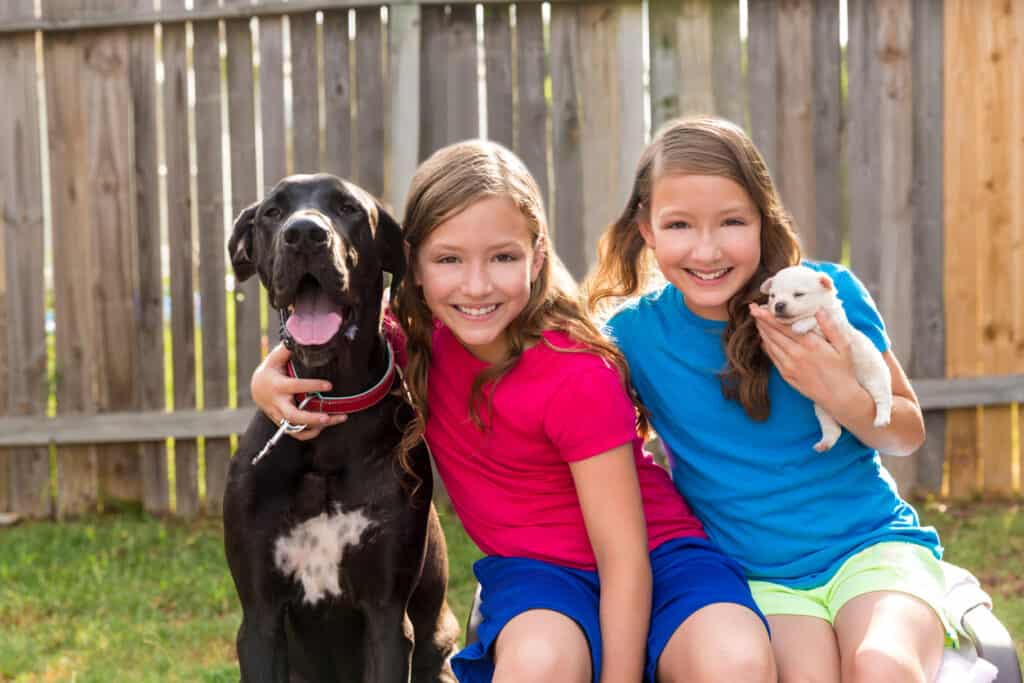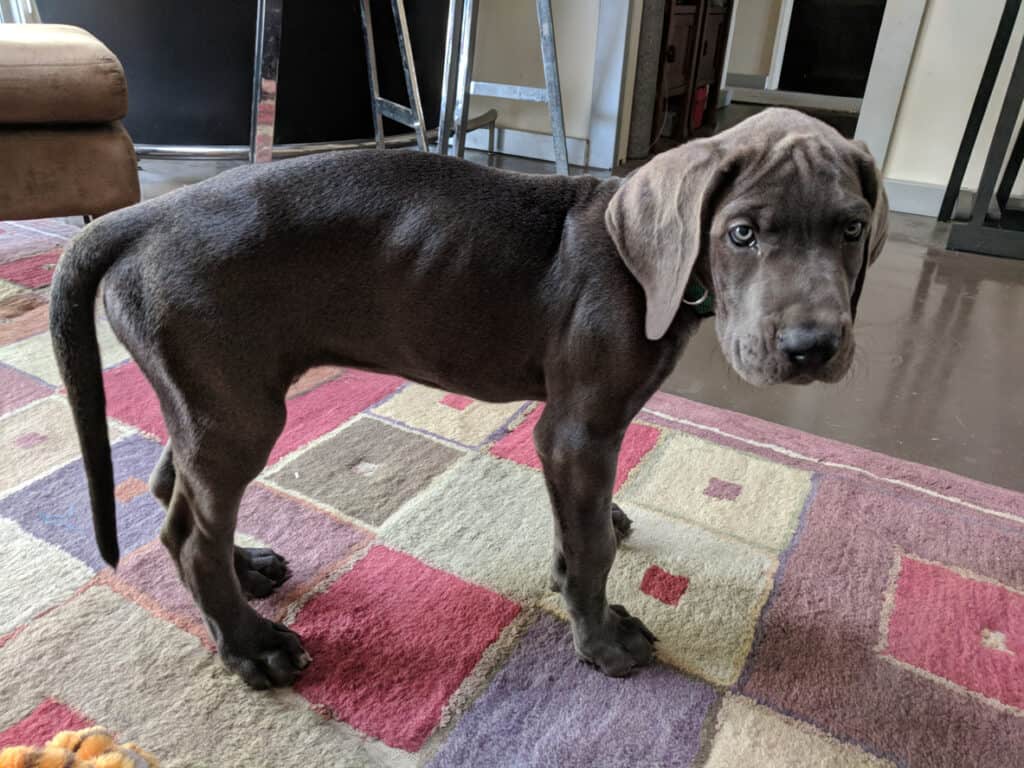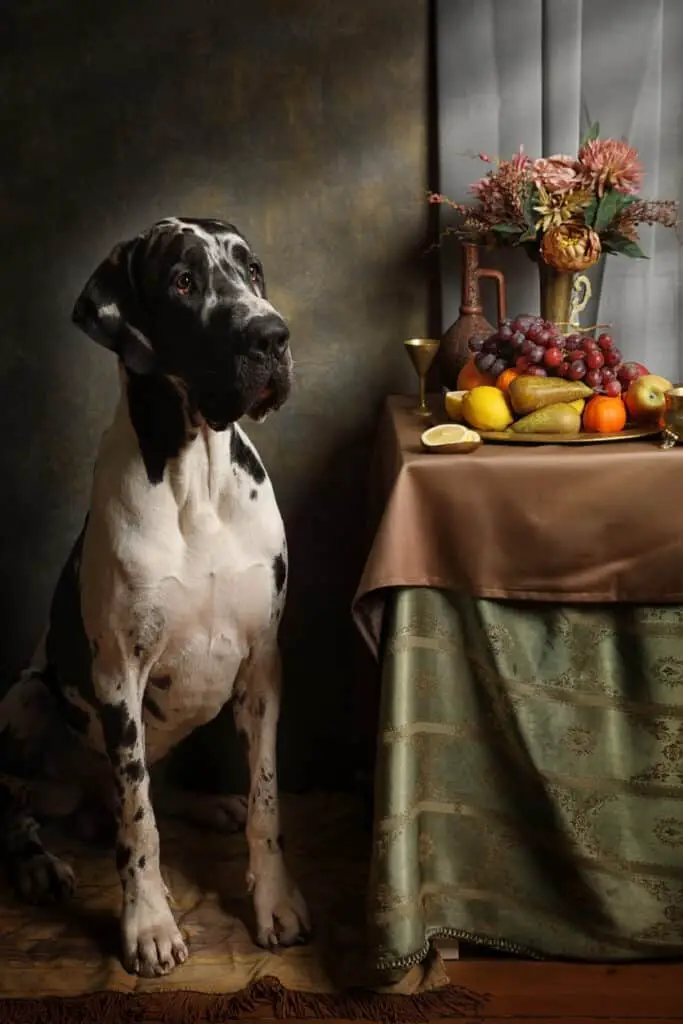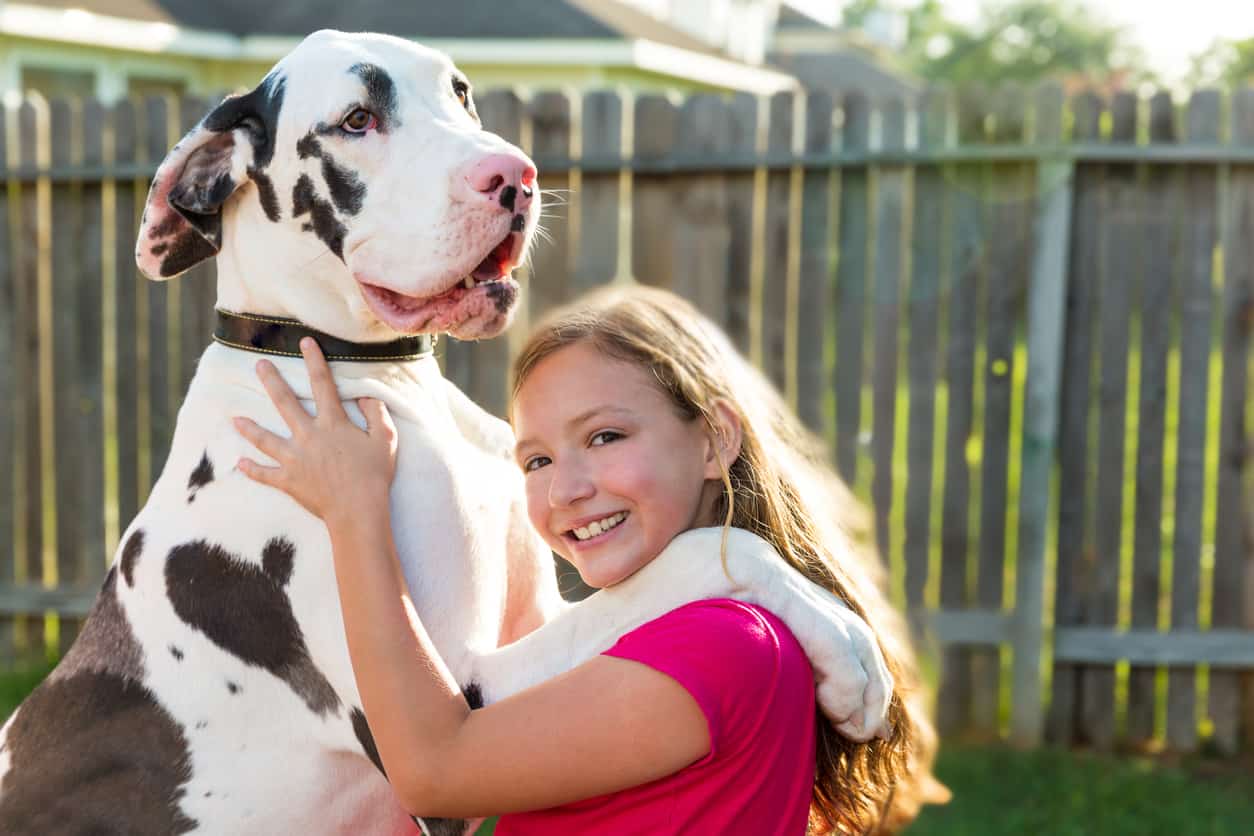Great Danes are temperamentally well-suited to living in a house with children. However, although they have been known to adapt well to apartment life, it is perhaps less advisable to bring a Great Dane into your family apartment simply due to the sizeable imposition Great Danes make. The gentle and easygoing nature of Great Danes make them compatible with the exciting and playful days that come with a life filled with children. Great Danes are also extremely affectionate and patient animals, so much so that they are often referred to as “The Nanny Dog.”

Great Danes are great with kids and other pets, they are even nicknamed “Gentle Giants”. It’s important to note that they’re still animals and have instincts, and how they were raised will greatly determine their temperament.
In addition to being all-around great family pets, there are certain characteristics that make the Great Dane appealing as a family dog, such as their protective instinct and their devotedness. As with all dog breeds, it’s important that prospective owners research their breeds of interest in order to gain a more well-rounded understanding of what breeds may be most suitable for their particular circumstances. For example, families considering buying or adopting a Great Dane should be aware that while as a baseline the breed makes an excellent family pet, there are certain aspects to be mindful of before bringing a Great Dane into the family.
Great Dane’s Temperament History

Great Danes have historically been used to hunt wild boar and provide security to German nobility. Contrary to what their name implies, they were not bred in Denmark and instead trace their lineage back to Germany where they are known as the Deutsche Dogge. This history makes them exceptionally loyal and are courageous animals. Today, they are mostly used as companion dogs and bring their owners no shortage of delight with their intelligence and eagerness to please, but it’s important that owners invest in properly training their Great Dane so that their positive characteristics do not spoil into behavioral issues. This investment in training becomes especially important if there are children (or are going to be children) in the picture.
Great Danes are classed in the Working Group by the American Kennel Club, meaning that they are not naturally suited for novice dog owners due to their strong sense of duty that can easily overwhelm an inexperienced owner. Also – Great Danes are huge, with males’ minimum height being between 30-32 inches at the shoulder and females between 28-30 inches. Thus, they require a uniquely tailored approach to training that bears in mind their size and strength, particularly where children are concerned. No one is going to force this breed to do anything, but that’s okay, because proper training relies on consistency and firm-but-gentle correction, never force.
Are Great Danes Smart?

Breeds in the Working Group are extremely intelligent and tend to have assertive personalities, meaning that it’s important for owners to know how to both properly train and manage breeds in this category. In the case of the Great Dane, the positive attributes that make it such a great pet under ideal circumstances can easily become exasperating, frustrating, or even dangerous under inexperienced ownership.
For example, while Great Danes are typically friendly dogs, it’s extremely important for them to be well-socialized beginning in puppyhood, but also regularly throughout their lives. This is because their instinct to protect their family will emerge under any scenario that a Great Dane feels threatened, and unfamiliar situations are one of the main triggers of feeling threatened.
Thus, buying or adopting a Great Dane as a family pet will require vigilant and constant supervision as you introduce your Dane to new stimuli and scenarios. Particularly when children are involved, it’s important to be both vigilant and quick to correct undesirable behaviors, but owners should never be harsh in their treatment of Great Danes.
Owners of Great Danes should also take care to educate their children on the importance of interacting correctly and safely with the family dog. While Great Danes are renowned for their patience and love of children, it is still important for children to learn how to regulate their behavior when engaging in playing with such a large, strong animal. Where newborns, very young children, or toddlers are involved, it’s important for owners to be extra vigilant and to provide consistent and clear guidance to the Great Danes.
Why are Great Danes so nice?
Great Danes are extremely sensitive animals. They long to please and respond well to obedience training, which is another important aspect to keep in mind when welcoming a Great Dane into the family. It’s important to begin obedience training from the moment you bring your Great Dane home because their size can quickly become a problem when interacting with children, particularly if those children are young or small. While a properly trained and socialized Great Dane will be a calm and mellow adult, Great Dane puppies are boisterous and love to run and play. Where children and Great Dane puppies are involved, the energy levels can quickly spike, and parents should always supervise these interactions so that the play session is fun, safe, and educational for children and puppy alike.
The most important lesson for a Great Dane puppy to learn when interacting with your children is that it is not equal to the children in terms of pack hierarchy. All dogs operate on the understanding that their families are “packs” with clearly defined hierarchies. Ideally, you, the owner, are at the top, and then your other family members, with the family dog being at the bottom.
However, this can be difficult to put into practice when you have a playful Great Dane puppy and playful human children – how is the Great Dane puppy to know that the human children are not littermates and therefore not eligible to supersede in the pack hierarchy? The answer to this question is complex and relies on ensuring that your puppy is trained consistently and firmly to understand that even though it may be the same size (or in some cases, larger) than children, it is not in fact dominant to them and dominant behavior will not be tolerated.
When it comes to creating a healthy and strong relationship between your Great Dane and children, it can be useful to educate your children on the importance of dog training. Of course, they need to be an appropriate age for learning these things, but even very young children can be taught basic rules for interacting with Great Danes that will help ensure that they are fun and safe for both animal and child alike. For example, one of the most important lessons a Great Dane puppy will learn is how to walk correctly on a leash. As this is not an inherent skill, investing time and energy into teaching your Great Dane puppy how to walk calmly at your side, as well as how to heel on command, will pay dividends in the long run for Great Dane owners who want to avoid challenging behavioral issues later on.
If a Great Dane puppy does not learn how to correctly walk on a leash, many issues can ensue. Great Dane puppies become animals weighing anywhere between 110 and 175 pounds depending on their sex and height, a size that can easily overpower most humans. Fortunately, the Great Dane’s temperament is docile and eager to please, meaning that once you’ve laid a strong foundation for obedience and leash walking, you can incorporate your children into the lessons by taking you child with you on walks with the family Great Dane.
While walking, you can explain the importance of being able to walk your Great Dane calmly, as well as demonstrate how to correctly hold the leash and encourage and reward good behavior. These walks are also excellent times to reinforce the family hierarchy to your Great Dane. By default, the person holding the leash should be considered superior to the Great Dane, meaning that behaviors such as straining at the leash are unacceptable whether the leash is held by an adult or a child. As an added bonus, these lessons also serve to raise a responsible, likely future dog owner – your child!
How people act matters too!
There are certain lessons that you can teach your children at any age that will help foster a healthy relationship between them and your Great Dane. Under no circumstances should children be permitted to climb onto the back of a Great Dane and attempt to “ride” them. There are a couple of reasons for this. First of all is safety for both the child and the animal – if a child climbs onto a puppy, the Great Dane’s still-developing bones could be injured.
Alternatively, if a child tries to climb onto an adult Great Dane, the animal could have an unpredictable reaction, resulting in an injury to your child. Additionally, at no age is the body of a Great Dane structured to support the weight of a child, so it’s simply good practice to lay this rule down firmly and early on: Great Danes are not for riding, under any circumstances.
While Great Danes are good with kids as a baseline, owners should always bear in mind the obvious when supervising play sessions between a Great Dane and children, especially if the Great Dane is adult. The obvious being, of course, that the Great Dane is a very large dog, and can easily knock down or even hurt a child if it becomes overexcited. In order to avoid over-excited behavior, owners can also teach their children to be mindful of the size of the Great Dane and to anticipate the potential consequences of, say, holding a ball up for the Great Dane to reach or jump up for. Even something as simple as making your Great Dane happy could have an unintended consequence for the unsuspecting child – a hard wag from a Great Dane tail is easily enough to knock a small child or toddler onto the ground.
In addition to carefully supervising play sessions between children and Great Danes and education children on how their behavior can influence that of the Great Dane’s, owners should also be able to provide the Great Dane with space away from children. This is most applicable to when the Great Dane is a puppy, as an adult Great Dane can more easily remove itself from interactions with children that have become tiring or annoying. Owners of a Great Dane puppy should have an appropriately sized crate for their puppy that provides the Great Dane with its own calm space to decompress and relax after a tiring play session or overstimulating experience.
The provision of a crate for your Great Dane puppy also offers a useful teaching moment for your children: when you feel overwhelmed or overexcited, it can be helpful to step away and take a quiet moment to yourself. It is also important to teach children that the crate must never be used as a punishment for a Great Dane puppy, as doing so will remove both the positive association and the feeling that the crate is a private safe haven of sorts. This is important to explain to children, who can be quite mischievous in the games they think up to play with a puppy, and may not realize that they are harming the psychology of a Great Dane puppy by doing something like playfully locking it in its crate or forcing it to come out. An easy way to explain the concept of a puppy’s crate to a child is to liken it to the child’s bedroom – the crate is the puppy’s bedroom where it goes to sleep and calm down and have its own space.
In sum, a Great Danes are great with children and genuinely enjoy them. They are natural guard dogs and have a knack for understanding that children require patience. In order to foster positive and healthy relationships between your Great Dane and your children, it is important that your Great Dane understand that children rank above it in the hierarchy, but it is also important to teach children how to interact respectfully with such a large and powerful dog. Easy ways of teaching children how to play safely with a Great Dane include taking the dog for a walk and playing games such as fetch. Great Danes require obedience training and lots of socialization beginning in puppyhood, with these two aspects of ownership promising to lay an excellent foundation for an overall great experience of owning a Great Dane while living with children.

